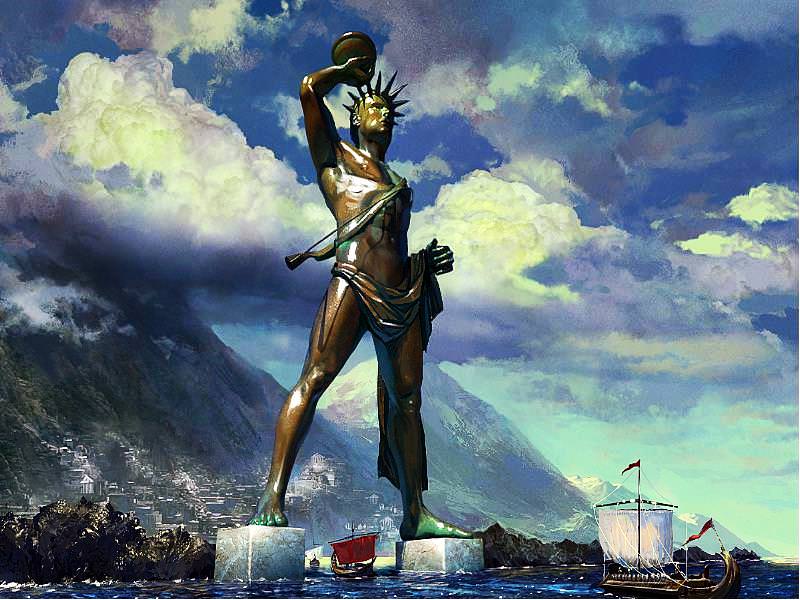
The spacing of the legs was not compatible with this situation: after static studies of British specialists, the pillars on which rested had the feet of the statue should have been separated from forty meters of According to the observations of the seabed in the Bay of Rhodes conducted by these researchers. This hypothesis emerged in the Renaissance, a statue with legs spread is unrealistic given the weight of the statue and the burden should support points. High about 14 meters shorter than the Statue of Liberty in New York, the colossal statue of the Colossus of Rhodes was visible to all ships heading to the island of Rhodes.Īccording to tradition, the Colossus stood at the entrance of the Mandraki harbor, signaling its entry into the browser with his torch, and ships passing between his spread legs. The Colossus of Rhodes represented Helios, the sun god and chief deity of Rhodes, standing, holding a torch in one hand he pointed to the sky, his other arm leaning on a spear and winner of sunlight, according Philo.įrom head to toe, the Colossus of Rhodes measured 79 cubits (32 m) tall and weighed 20 tons few men could kiss his thumb, and the length of his fingers surpassed the height of ordinary statues. The uncompromising sculptor ended his days when he discovered an error in his calculations, the error was corrected later by one of his assistants. The Colossus of Rhodes is the sculptor Chares, a native of Rhodian Lindos, famous disciple of Lysippus, whose best known works are Eros Cordant bow at the Capitoline Museum, the portrait of Alexander the Great at the Glyptotek in Munich Silenus child Dionysus Chiaramonti Museum, the Pugilist at the Spa Palace Massimo alle Terme, Apoxyomenos museum Pio-Clementine Vatican Farnese Hercules and the National Archaeological Museum of Naples.

The foundry of the island is not sufficient to fulfill the requirements of such an undertaking, it was necessary to import large quantities of copper.Įxpenditure for the construction of the Colossus was 300 talents. Cast in place in molds of clay, the statue was gradually rising through a scaffolding blocks of stone ballast to allow different parts of the body at the time of assembly. Once the frame in place, the wooden structure was covered with huge bronze plaques. The Colossus was entirely made of wood and bronze with a marble base. The construction of the statue 32 m high lasted only 12 years, which means for the time, remains a technical challenge. The statue was built between 304 and 292 BC by Chares of Lindos. With the money raised, they decided to erect a magnificent bronze statue to thank their patron, the Greek sun god Helios. The son of the king of Macedon Demetrius Poliorcetes besieged the island of Rhodes, but could not overcome the Rhodians who had sent reinforcements Ptolemy (305-304 BC).Īfter some hard battles, the Macedonians failed to take Rhodes, leaving a large part of their military equipment that is sold by the inhabitants of Rhodes. The Colossus of Rhodes was built to celebrate the strength of the Rhodians allies Egypt the Greek dynasty of the Ptolemies, armies of Monophtalmos Antigone, King of Macedonia. The Colossus of Rhodes is known to us through ancient writings (Polybius, Strabo, Pliny, Lucian) and Byzantine chronicles (Philo, Michael the Syrian and Constantine Porphyrogenitus). Please tick the box below if you found this review helpful.Rhodes is known for the Colossus of Rhodes, a huge statue overlooking the harbor of Rhodes town and was one of the seven wonders of the world. TIP: Come at sunset to take some incredible Photos. Today, there are two columns, with a Roe and Buck Deer standing respectively on top of either side of the entrance to Mandraki Harbor. When the Arabs captured Rhodes in 653 AD, they sold the scrap metal to a Jewish merchant whom they say needed 900 camels to take it away. The locals, thinking that it was cursed, left it untouched for eight hundred years. It took 12 years to build and unfortunately fell victim to an earthquake 66 years later.

Finance for this project came from selling the siege equipment he left behind. According to legend, an enormous 33-metre-high bronze statue of the sun god Helios was built by Greek sculptor Chares of Lindo’s in 282 BC, to commemorate Rhodes' victory after the siege of Demetrios the Besieger in 305 BC. Many believe that this was not the location of the Colossus of Rhodes and that it had stood on higher ground where the Grand Master Palace is now. Knowing the story of the Colossus of Rhodes, and how it was once one of the seven wonders of the old world, we did not expect to see anything spectacular standing in its place at the entrance to Mandraki Harbor.


 0 kommentar(er)
0 kommentar(er)
